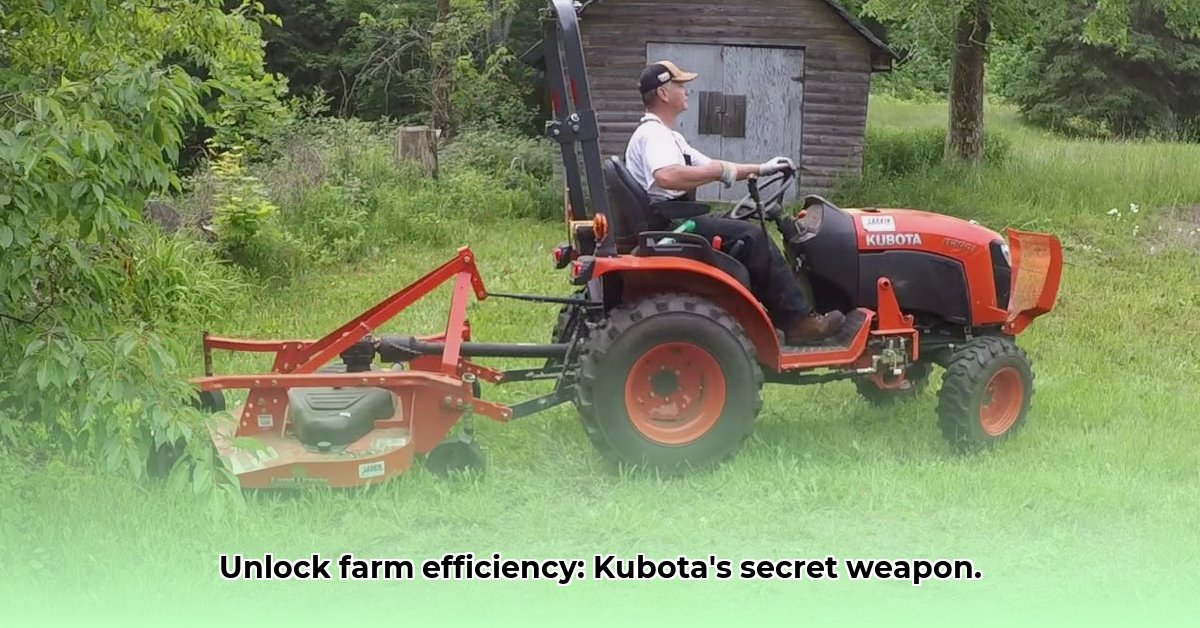
Kubota Tractor Mower Attachments: A Sustainable Farming Approach
Sustainable agriculture is crucial for the future of farming. This guide explores how Kubota tractor attachments can contribute to more efficient and environmentally friendly practices. We'll examine specific attachments, offer practical tips for maximizing sustainability, and address the need for greater transparency regarding the environmental impact of agricultural equipment. For more detailed Kubota tractor information, check out this helpful resource: Kubota Tractor Steps.
Kubota and Sustainable Practices: Transparency and Efficiency
Kubota is known for its reliable agricultural machinery. However, comprehensive data on the long-term environmental impact of their attachments—including emissions and material sourcing—is lacking. While their focus on efficient equipment design suggests a commitment to sustainability, more detailed information is needed for farmers to make fully informed decisions. This guide aims to bridge that gap by focusing on practical applications and strategies.
Attachment Spotlight: Optimizing for Sustainability
Let's explore how specific Kubota attachments contribute to sustainable farming.
Rotary Cutters: Efficient Mowing with Reduced Fuel Consumption
Rotary cutters are essential for pasture and hayfield maintenance. Their efficiency compared to manual methods significantly reduces labor and fuel consumption. However, maintaining sharp blades is vital; dull blades increase fuel usage and reduce cutting quality. Regular maintenance is key to maximizing their sustainability benefits. Isn't it remarkable how a small detail like blade sharpness can impact your farm's efficiency and environmental footprint?
Disk Harrows: Minimizing Soil Disturbance for Enhanced Soil Health
Disk harrows offer a gentler approach to soil preparation than plowing. They break up soil clods while minimizing soil disturbance, reducing erosion and preserving topsoil—a cornerstone of healthy, productive crops. This reduced soil disturbance also saves fuel compared to heavy plowing. However, their effectiveness can be limited in rocky or heavy clay soils. How can you assess if a disk harrow is the best option for your soil type?
Rotary Tillers: Aeration and Water Absorption—with Cautious Use
Rotary tillers improve soil aeration and water infiltration by pulverizing the soil, leading to healthier root systems and better yields. However, over-tilling can lead to soil compaction, negating these benefits. The key is to till only when necessary and to the appropriate depth. Why is careful consideration of tilling frequency and depth so vital for sustainable land management?
Grading Scrapers: Efficient Land Leveling and Water Management
Grading scrapers are valuable for land leveling and improved drainage. Efficient water management minimizes erosion and ensures even water distribution, leading to better crop yields and reduced water waste. However, operating a grader efficiently requires skill to get smooth and consistent results. What practical steps could a farmer take to improve their grading skills and maximize the efficiency of this attachment?
Maximizing Sustainability with Kubota Attachments: Practical Tips and Strategies
Effective use of Kubota attachments is critical for sustainable farming. This section offers actionable strategies.
Preventative Maintenance: Regular maintenance extends equipment lifespan, reducing waste and resource consumption associated with replacements. A well-maintained machine operates more efficiently and lasts far longer, thereby increasing the return on your investment.
Fuel Efficiency Techniques: Maintain proper tire pressure, keep your engine tuned, and minimize idling. These small steps drastically impact fuel consumption over time. Efficient attachment usage directly affects fuel burn. Did you know that proper tire inflation can increase fuel efficiency by up to 15%?
Smart Soil Management Practices: Avoid over-tilling. Consider no-till or reduced-till methods. Use attachments appropriate to your soil type to conserve fuel and avoid unnecessary soil disturbance. How does reduced-till farming positively impact soil health and long-term productivity?
Right-Sizing Equipment: Selecting attachments properly sized for your operation avoids fuel waste and potential soil compaction from oversized equipment. Matching your attachment to your farm’s size and needs is a fundamental aspect of efficient agriculture.
Addressing the Data Gap: The Need for Transparency
The lack of comprehensive data on the complete lifecycle sustainability of Kubota attachments is a concern. Manufacturers need to provide more transparent data on fuel efficiency, emissions, and material sourcing to allow farmers to make truly informed decisions. In the absence of this data, farmers can independently track fuel consumption and equipment maintenance to gather valuable information on their own operations.
The Future of Sustainable Farming with Kubota: Looking Ahead
Sustainable agriculture requires continuous innovation. We can expect advancements in engine technology, more efficient attachments, and data-driven farming practices. Manufacturers like Kubota have a crucial role to play in providing the necessary data and equipment to facilitate these advancements. What are some of the most promising innovations in sustainable agricultural technology that could benefit farmers in the coming years?
Kubota Tractor Mower Attachment Comparison
| Attachment Type | Advantages | Disadvantages | Considerations |
|---|---|---|---|
| Rotary Cutter | Efficient, labor-saving, relatively fuel-efficient | Potential for soil compaction with misuse | Blade sharpness, regular maintenance |
| Disk Harrow | Minimizes soil disturbance, reduces erosion | Less effective in rocky or heavy clay soils | Soil type, proper depth setting |
| Rotary Tiller | Improves aeration and water infiltration | Potential for soil compaction if overused | Proper depth and frequency of use |
| Grading Scraper | Improves water management, minimizes erosion | Requires skill for even grading | Terrain suitability, appropriate scraper size selection |
By implementing these strategies and advocating for greater transparency from manufacturers, farmers can actively contribute to a more sustainable agricultural future.